Early morning rise is always a good time to observe daytime birds as they begin their day activities. Observe where they perch and roost, what they feed on, when they poo, colour of their plumages, dramatic features, how they socialise, their calls, where their favourite habitats are determined, survival instincts of fight or flee from predators, breeding habits, nesting and parental roles in reproducing their species.
My discovery of a nesting pair of Coppersmith Barbets (Megalaima haemacephala) close to home provided many opportunities to observe their nesting routines and behaviours for documenting photographic sequential digiscopy shots.
Routine observations began just before 8am. The dry and hot season of January and February stripped semi-deciduous trees off foliage, leaving only skeletal branches to hang against the sky. Most digiscopy shots were back lighting shots taken at least 70 degrees elevation and 20-30 feet away from nesting site.
Over five mornings, Nightshift bird was seen daily and frequently peeping from nest cavity. Time ranges from 0807hs-0834hs before being relieved by Dayshift bird. These two images show Nightshift’s exit at 0811hs and 0834hs taken in two different mornings (left).
What does Nightshift do whilst waiting for Dayshift to show?
Let’s take a look at these sequential shots taken 29th January 2009 over an 18 minutes observation period (top down, left to right).
The usual classical 3-step look-out approach- ‘Look right, look left and front/right again’ was executed.
Feeling restless, one of the birds appeared to have the habit of climbing out of the cavity hastily, clinging on to the edge, a quick look, made a re-entry, turned around, looked out and waited for Dayshift’s call.
Here are two more images taken on two different days at 0809hs and 0815hs (above left and middle).
Nightshift too has the job of also throwing out the night ‘rubbish bag’ and this was first observed on 31st January 2009 (above right).
What’s in the bag apart from wood shavings? Seen anything different yet..?
Join me next to observe Dayshift’s synchronising show of some good, teamwork.
AVIAN WRITER DAISY O’NEILL PENANG MALAYSIA
© OF NESTING SHIFT DUTIES & COPPERSMITH BARBETS (Part 2)
All images taken by Digiscopy techniques
Optics used: Fieldscope ED82 +30x + Coolpix P3



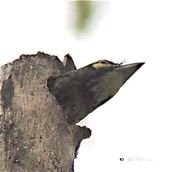
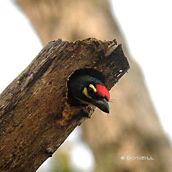
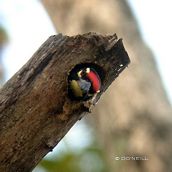
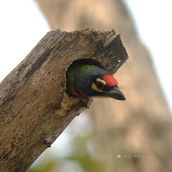
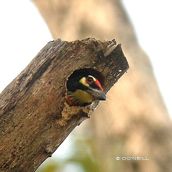

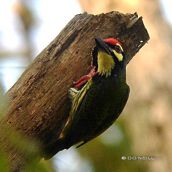
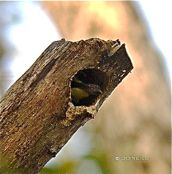

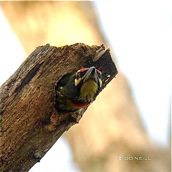
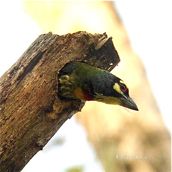

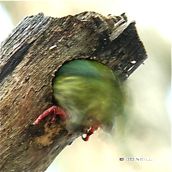









2 Responses
Are there any declines in the coppersmith within urban environments in Singapore ?
There seem to be big declines in India and there are some suggestions that the larger species of barbet compete, even by evicting the young of coppersmiths, and are able to capitalize on some introduced fruit trees such as Muntingia.
Not that we know of.